RBSE Solutions for Class 9 Science Chapter 11 Sound are part of RBSE Solutions for Class 9 Science. Here we have given Rajasthan Board RBSE Class 9 Science Chapter 11 Sound.
| Board | RBSE |
| Textbook | SIERT, Rajasthan |
| Class | Class 9 |
| Subject | Science |
| Chapter | Chapter 11 |
| Chapter Name | Sound |
| Number of Questions Solved | 110 |
| Category | RBSE Solutions |
Rajasthan Board RBSE Class 9 Science Chapter 11 Sound
Sound Textbook Questions Solved
Objective Type Questions
Question 1.
Wave that contains compression and rarefaction is called
(A) Transverse wave
(B) Longitudinal waves
(C) Light rays
(D) Ultraviolet ray
Answer: B
Question 2.
The relation between wave velocity (V), wave length and frequency (v) is:
(A) V = vλ
(B) λ= Vv
(C) V =λv
(D) V= λ/v
Answer: A
Question 3.
Longitudinal waves can be produced in:
(A) Solid and liquid
(B) Solids and gases
(C) Gases and liquids
(D) Solid, liquid and gases
Answer: B
Question 4.
In longitudinal waves, the vibration of the particles of the medium:
(A) is /are always in the direction of the wave
(B) is/ are always perpendicular to the direction of the wave
(C) molecules do not vibrate at all
(D) at an angle of 60o from the direction of wave
Answer: A
Question 5.
The speed of sound is maximum in:
(A) Air
(B) Solid
(C) Water
(D) Both in liquid and solid
Answer: B
Question 6.
In a clock, the time period of hour hand is:
(A) 1 hour
(B) 24 hours
(C) 12 hours
(D) None of these
Answer: C
Question 7.
The speed of a wave is 350 m/s and its wavelength 50 cm, then the frequency of the wave will be:
(A) 13500 Hz
(B) 700 Hz
(C) 400 Hz
(D) 300 Hz
Answer: B
Question 8.
A number of oscillation completed per second is called:
(A) Amplitude
(B) Speed
(C) Time period
(D) Frequency
Answer: D
Question 9.
The time period of a vibrating body is 0.02s. The frequency of the vibrating body will be
(A) 100 Hz
(B) 20 Hz
(C) 50 Hz
(D) 1Hz
Answer: C
Question 10.
The time period of the second hand in a clock is:
(A) 1 minute
(B) 1 hour
(C) 12 hours
(D) 24 hours
Answer: A
Question 11.
Human audible range is:
(A) 200 Hz to 20000 Hz
(B) 20Hz to 20000Hz
(C) 2 Hz to 20 Hz
(D) Above 20000Hz
Answer: B
Question 12.
The minimum time required to hear an echo,
(A) 0.1 S
(B) 0.5 S
(C) 1 S
(D) 2 S
Answer: A
Question 13.
The frequency of the waves used in ultrasonography is:
(A) 20 Hz
(B) Below 20 Hz
(C) 20 Hz to 20000 Hz
(D) Above 20000 Hz
Answer: B
Question 14.
The unit of amplitude is:
(A) m
(B) m/s
(C) Hz
(D) None of these
Answer: A
Question 15.
The speed of sound in a vacuum is:
(A) 3 x 108 m/s
(B) 330 m/s
(C) A sound wave cannot travel in the vacuum
(D) None of these
Answer: C
Sound Very Short Answer Type Questions
Question 16.
Name the medium in which longitudinal waves can be produced.
Answer
Longitudinal waves can be produced in all the three mediums i.e. (solid, liquid and gases).
Question 17.
Name the type of sound waves produced in iron?
Answer
Longitudinal waves.
Question 18.
Name the sound wave produced in the air?
Answer
Longitudinal waves.
Question 19.
A wire is tied between the two knobs and released perpendicular to its length. Name the wave produced in the wire.
Answer
Transverse waves are produced in the wire.
Question 20.
What is the S.I unit of wavelength?
Answer
Metre (m).
Question 21.
What is the S.I unit of frequency?
Answer
S.I unit of frequency is Hertz.
Question 22.
A slinky is held freely, now if we pull the free end of slinky and release, then what type of wave will be produced?
Answer
Longitudinal waves.
Question 23.
What type of motion do the hands of a clock exhibits?
Answer
Periodic motion.
Question 24.
Define wavelength?
Answer
The distance between the two nearest points on the wave which is in the same phase is called its wavelength.
Or
The distance between the two nearest crests through of a transverse wave is called its wavelength. It is denoted by Its S.I unit is a metre (m).
Question 25.
Define frequency.
Answer
The number of wave cycles of a wave that pass a given point in one second is called its frequency. The S.I. the unit of frequency is Hertz (Hz),
(1 Hertz = 1 wave cycle per second).
Question 26.
What is RADAR?
Answer
The word RADAR is an acronym derived from the word RADIO DETECTION AND RANGING. It refers to the technique of using radio waves to detect the presence of objects in the atmosphere.
Sound Short Answer type Questions
Question 27.
How do we produce sound?
Answer
The sound is produced when an object is set to vibrate or we can say that vibrating objects produce sound. The sound of the human voice is produced due to vibration in the vocal cord. We can produce sound by striking the tuning fork, by plucking, scratching, rubbing, blowing or shaking two objects. All objects produce sound due to vibration.
Question 28.
What do you understand by wave motion?
Answer
Wave motion is a mode of transfer of energy from place to place without material support. It is a kind of disturbance which travels through a material medium.
Question 29.
What are Longitudinal waves?
Answer
Longitudinal waves: A wave in which the particle of the medium oscillate to and fro about their mean position in the direction of propagation of the wave is called Longitudinal waves.
Examples:
(a) Sound waves are longitudinal waves,
(b) The wave produces in spring.
Question 30.
What is necessary for wave propagation?
Answer
Waves require a medium to travel. The substance through which wave travels is called medium. It can be solid, liquid or a gas. Mechanical wave requires a material medium like air, water, steel etc. for its propagation. The wave cannot travel in a vacuum.
Question 31.
In wave propagation, from one position to another position, what type of transfer takes place, ‘Energy or matter”.
Answer
Energy.
Question 32.
Give two examples of Longitudinal waves?
Answer
Examples of longitudinal waves are:
- Sound waves travelling through water.
- Wave produced in spring by compressing a small portion of it and then releasing
Question 33.
Is the bullet fired from a gun and a stone from a slingshot follow wave motion?
Answer
Yes, the bullet fired from a gun and a stone from a slingshot will follow wave motion.
Question 34.
Describe the uses of RADAR and its system of locating position?
Answer
- It is an important tool in weather forecasting and helps to make the forecast more accurate.
- It is used to locate the surface to air missiles (SAM).
- It is used in locating the position of outsider aeroplane.
- It is used frequently by scientists to track the migration patterns of animals.
- To determine the range, altitude, direction or speed of both moving and fixed objects such as aircraft, ships, spacecraft etc.
RADAR as a position locating device: Nowadays RADAR has a video monitor that shows the location of all the detected objects within the range of the RADAR device. The computer measures the time, it takes for the signal to reflect off the target and then, calculates how far it is. The basic idea behind the RADAR is: A signal is transmitted, it bounces off an object and it is later received by the same type of receiver. The cathode ray oscilloscope of receiver detects the exact position of an object.
Question 35.
Distinguish Longitudinal waves and Transverse waves?
Answer
| Longitudinal waves | Transverse waves |
| 1. In longitudinal waves, the particles of the medium oscillate along the direction of propagation of the wave. | 1. In a transverse wave, the particle of the medium oscillates in a direction perpendicular to the direction of propagation of the wave. |
| 2. Longitudinal waves consist of compressions and rarefactions. | 2. Transverse waves consist of crests and thoughts. |
| 3. Longitudinal waves can propagate in any medium i.e. solid, liquid and gases. | 3. Transverse waves can propagate through solid and on the surface of the water, but not through gases. |
Sound Long Answer Type Questions
Question 36.
Write the definition of the following:
(a) Amplitude
(b) Frequency
(c) Time period
(d) Wavelength
Answer
(a) Amplitude: The magnitude of the maximum disturbance in the medium on either side of the mean position is called the amplitude of the wave. It is usually represented by the letter A.
(b) Frequency: The change in density from the maximum value to the minimum value, again to the maximum value, makes one complete oscillation. The number of such oscillations per unit time is called the frequency of the sound wave, represented by v. It S.I. the unit is Hertz (symbol, Hz).
(c) Time period: The time taken by two consecutive compressions or rarefactions to cross a fixed point is called the time period of the wave. It is represented by the symbol T. Its S.I. the unit is second (s).
(d) Wavelength: The distance between two consecutive compressions (C) or, two consecutive rarefactions (R) in sound waves, is called the wavelength, represented by X Its S.I. the unit is a metre (m).
Question 37.
Find the relation between:
(a) The time period and frequency.
(b) Frequency, wave length and velocity.
Answer
(a) Let T? the time period of a vibrating body
The number of oscillations completed in T sec = 1
Number of oscillations completed in 1 sec = \(\frac { 1 }{ T } \)
But the number of oscillation completed in 1 sec in known as frequency (ν)
∴ ν= \(\frac { 1 }{ T } \) ⇒ \(Frequency=\frac { 1 }{ T } \)
(b) The relationship between speed, frequency and wavelength of a wave
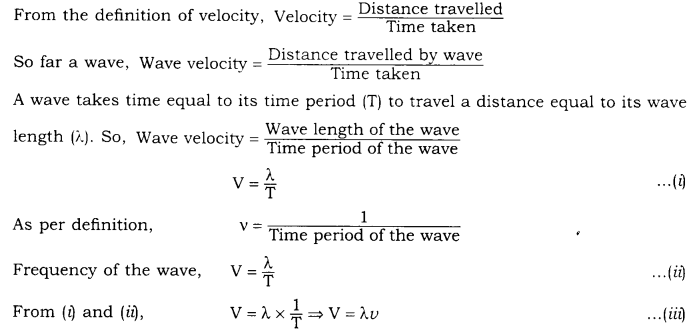
⇒Wave velocity = Wavelength x Frequency
The above equation is known as the wave equation. This statement is true for all the types of waves. The velocity of a wave depends on the medium.
Question 38.
Answer the following:
(a) Find the distance covered by any particle of the medium when it complete one oscillations.
(b) Sound waves travelling in air are longitudinal or transverse.
(c) Name the wave/waves produced in a long slinky.
(d) Give two examples each of transverse and longitudinal waves.
(e) Name the physical quantity whose unit is Hertz.
Answer
(a) The distance covered by any particle of the medium when it completes one oscillation is equal to the wave length.
(b) Sound waves travelling in air are longitudinal waves.
(c) Wave length produced in a long slinky is longitudinal waves.
(d) Examples of transverse waves are:
- All electromagnetic waves i.e. light waves, radio waves etc. are a transverse wave.
- The water waves produced on the surface of the water are transverse waves. In water waves, the molecules of water move up and down from their mean position.
Examples of longitudinal waves:
- Sound waves.
- Waves produced in a slinky, by compressing a small portion of it and then releasing life.
Frequency is the physical quantity, whose S.I. the unit is Hertz.
Question 39.
Give five uses of ultrasonic waves?
Answer
- Ultrasonic waves are used in echocardiography It is used to construct the image of the heart(it)
- Ultrasonic waves are used in the detection of cracks in metal blocks.
- Ultrasonic waves are used to kill bacteria in liquid.
- Ultrasonic waves for determining the depth of the sea.
- Ultrasonic waves is also used to see what is happening to the components inside a nuclear reactor.
Question 40.
Write a full form of SONAR. How do you determine the depth of the sea using echo ranging?
Answer
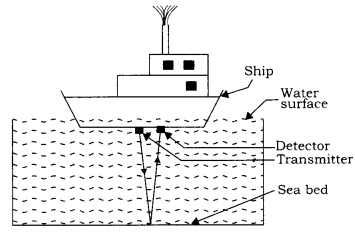
SONAR: The acronym SONAR stands for sound Navigation and Ranging.
This technique is used by ships to detect the presence of submarines, icebergs, sunken ships etc. in the sea. SONAR is a device that uses ultrasonic waves to measure the distance, direction and speed of under water objects. Sonar can also be used for determining the depth of the sea.
Determination of the depth of a sea using SONAR
Let the time interval between transmission and reception of ultrasound signal be t and the speed of sound through sea-water be v. The total distance, 2d travelled by the ultrasound is -2d = v x t
Question 41.
Explain with figure how does human ear works?
Answer
Structure of Human Ear Sound waves from outside is collected by external ear (known as Pinna) and reach the eardrum through the auditory canal. When the sound waves strike the eardrum, it starts vibrating. These vibrations are transmitted across the middle ear by the three ossicles called (the hammer, anvil and stirrup).
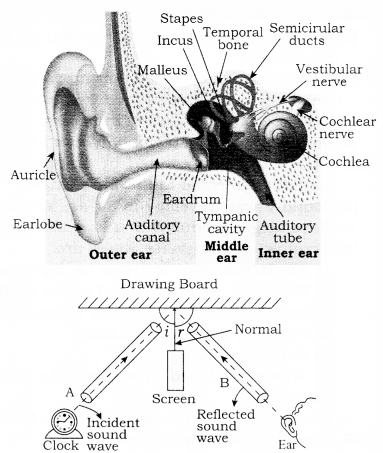
The vibrations produced by the eardrum are amplified. The amplified vibrations are then transmitted to the cochlea. The cochlea is coiled and fluid-filled tube, having the sense organ for hearing. The vibrations of the liquid in the cochlea affect thousands of auditory nerves, which send messages to the brain.
Question 42.
State the laws of Reflection of Sound. Arrange an activity to prove these laws?
Answer
Laws of reflection of sound:
(1)The direction in which the sound is incident and reflected, make equal angles with the normal to the reflecting surface.
(2) The direction in which the sound is incident, the direction in which sound is reflected and the normal to the reflecting surface, all lie in the same plane.
Activity: Take a drawing board and fix it in the vertical position on the table. Put two metallic cardboard tubes A and B. These tubes make some angle with each other. Put a clock near one end of the tube A and a solid screen between the two tubes, so that the sound of the clock may not be heard directly by the ear placed in front of the second tube.
The sound waves after reflecting from the drawing board enter the second tube and are heard by the ear placed in front of the second tube. Go on adjusting the position of the second tube B, till the loudness of the sound heard through the second tube becomes maximum. At this stage, the incident angle which is the law of reflection.
Question 43.
What is ultrasound? Explain how defects in a metal block can be detected, using ultrasound and explain how ultrasound is used to clean spiral tubes.
Answer
The sound frequencies greater than 20000 Hz are called ultrasonic waves or ultrasound. Human beings cannot hear ultrasound. Dogs, bats and dolphins can hear ultrasound. Due to very high frequency, ultrasound has greater penetrating power than ordinary sound.
Detection of defects in metal blocks: In this process, ultrasound waves are allowed to pass through the metal block and detectors are used to detect the transmitted waves. Even if there is a small defect, the ultrasound gets reflected back, indicates the presence of the flaws or defect.
Cleaning of spiral tubes: Ultrasonic waves are used for cleaning spiral tubes. The object to be cleaned is kept in the cleaning solution and the solution is subjected to the ultrasonic waves. The high-frequency waves stir up the dust/dirt particles. These particles get detached and the spiral tubes get thoroughly cleaned.
Question 44.
Enlist the elements and uses of RADAR?
Answer
Elements of RADAR are:
- Modulator: It is used to superimpose electrical audio signal on high-frequency carrier waves. The resultant waves are known as radio waves.
- Radio frequency oscillator: It produces the beats of high-frequency power. These beats form the signals of RADAR.
- Antenna: Through Antenna, signals are transmitted and received.
- Receiver: It receives the incoming radio signals.
- Indicator: It collects the information, sends by radio waves.
Uses of RADAR:
- In navigation of aeroplanes and ships.
- In launching of rockets and missiles.
- In the G.P.S system.
- In locating the enemies aeroplane, missiles and ships.
- In monitoring of animals, through radio collar.
Sound Addition Questions Solved
Multiple Choice Questions (MCQs)
Question 1.
The region of minimum density through which a wave propagates is called:
(A) Compression
(B) Rarefaction
(C) Crest
(D) Trough
Answer: B
Question 2.
Nature of sound wave is:
(A) Electromagnetic
(B) Transverse
(C) Longitudinal
(D) Seismic
Answer: C
Question 3.
The minimum distance between the source of the sound and the obstacle for an echo (at 20°C) to take place is:
(A) 17.2 m
(B) 1.72 m
(C) 17.8 m
(D) 34.4 m
Answer: A
Question 4.
To change a loud sound into feeble sound, we decrease its:
(A) amplitude
(B) wavelength
(C) frequency
(D) velocity
Answer: A
Question 5.
Ultrasound is used to:
(A) get images of internal body parts
(B) detect cracks and flaws in metal blocks
(C) clean parts hard to reach
(D) All the above
Answer: D
Question 6.
Before the main shock wave, earthquake produces:
(A) audible sound
(B) ultrasound
(C) infrasound
(D) none of the above
Answer: C
Question 7.
Infrasound is the sound with frequencies:
(A) above 20 kHz
(B) below 20 Hz
(C) between 20 Hz and 20 kHz
(D) all the above
Answer: B
Question 8.
One tuning fork completes 1000 oscillations in 5 seconds, its frequency is:
(A) 1000 Hz
(B) 0.005 Hz
(C) 200 Hz
(D) 5000 Hz
Answer: C
Question 9.
In SONAR, we use:
(A) audible sound waves
(B) radio waves
(C) ultrasonic wave
(D) infrasonic waves
Answer: C
Question 10.
Infrasound can be heard by:
(A) Elephant
(B) bat
(C) human beings
(D) dog
Answer: A
Question 11.
A speed greater than that of any type of sound waves is said to be:
(A) infrasonic speed
(B) sonic speed
(C) ultrasonic speed
(D) supersonic speed
Answer: D
Question 12.
Before playing the orchestra in a musical concert, a sitarist tries to adjust the tension and pluck the string suitably. By doing so, he is adjusting:
(A) the intensity of sound only
(B) the amplitude of sound only
(C) the frequency of sitar string with the frequency of another musical instrument
(D) the loudness of sound
Answer: C
Question 13.
Note is a sound:
(A) of a mixture of two frequency only
(B) of a mixture of several frequencies
(C) always unpleasant to listen
(D) of a single frequency
Answer: D
Question 14.
Hertz is a unit of:
(A) frequency
(B) wavelength
(C) wave speed
(D) displacement
Answer: A
Question 15.
The amplitude of a sound is doubled and the frequency is reduced to one fourth the intensity of sound at the same point will be:
(A) increased by a factor of 2
(B) increased by a factor of 4
(C) decreased by a factor of 2
(D) decreased by a factor of 4
Answer: D
Sound Very Short Answer Type Questions
Question 1.
Which mechanical waves are associated with
(a) compression and rarefaction
(b) crest and troughs
Answer
(a) Longitudinal Waves: e.g., Sound waves, waves produced in a slinky.
(b) Transverse wave: Light waves wave produced on the surface of the water (Ripples).
Question 2.
Which wave property determine
(a) Loudness
(b) Pitch
Answer
(a) The amplitude of vibrations determines the loudness of sound.
(b) A frequency of the sound determines its pitch.
Question 3.
Explain how is a sound produced by your school bell?
Answer
When the bell is hammered, vibrations are produced by it. These vibrations produce sound.
Question 4.
Why are sound waves called mechanical waves?
Answer
Sound waves are called mechanical waves because sound needs a material medium for its propagation.
Question 5.
Name the waves used to break small stones formed in the kidneys into fine grains.
Answer
Ultrasound waves / Ultrasonic waves.
Question 6.
A girl hears an echo of her own voice from a distant tall building after 2s. What is the distance of the girl from the building?
Answer
t = 2s, ν = 332 m/s, s = ?
Required distance
\(s=\cfrac { \upsilon t }{ 2 } =\cfrac { 332\times 2 }{ 2 } =332m \)
Question 7.
What are infrasonic and ultrasonic sounds?
Answer
A sound which has a frequency less than 20 per second is called infrasonic sound.
A sound which has frequency more than 20000 per second is called ultrasonic sound.
Question 8.
Distinguish between loudness and intensity of sound.
Answer
Loudness:
- Loudness is the measure of the response of ear to the sound.
- Loudness depends on the sensitivity of the ear.
Intensity:
- Intensity is the amount of energy passing per unit area.
- The intensity of sound does not depend on the sensitivity of the ear.
Question 9.
What is the audible range of the average human ear?
Answer
20 Hz to 20000 Hz.
Question 10.
In which of the three mediums; air, water and iron, does sound travel the fastest at a particular temperature?
Answer
Sound travels fastest through iron.
Question 11.
Guess which sound has a higher pitch: guitar or car horn?
Answer
Guitar has a sound of higher pitch.
Question 12.
Give two practical applications of reflection of sound waves?
Answer
(a) In a stethoscope, the sound of a patients heartbeat is guided along the tube of the stethoscope to the doctor’s ear, by multiple reflections of sound.
(b) Soundboards are used in a big hall to direct the sound waves to people.
Question 13.
What are longitudinal waves?
Answer
Longitudinal waves are the waves in which medium particles vibrate in the direction of wave propagation.
For example, sound waves.
Question 14.
What should be the minimum distance between the source of the sound and the reflector for the formation of echo?
Answer
For the hearing an echo, the minimum distance between the sound of the source and the reflector should be 17.2 metres.
Question 15.
Why are we able to hear the sound produced by the humming bees while the sound of vibrations of the pendulum is not heard?
Answer
This is because the frequency of sound produced by humming bees lies inaudible range and frequency of the sound of vibrations of pendulum lies in the infrasonic region. ,
Question 16.
Write the full form of ‘SONAR’.
Answer
Sound Navigation and Ranging.
Question 17.
Define reverberation.
Answer
The multiple reflection of sound in a hall is called reverberation.
Question 18.
Which characteristic of sound depends on the amplitude of a sound wave?
Answer
Loudness of sound depends on the amplitude of the sound wave.
Question 19.
Write the relation between the frequency and wavelength of the sound wave?
Answer
The relation between frequency and wavelength
is given by v = \(\cfrac { \lambda }{ T } \)
where, v = frequency, a = wavelength, T = time period
Question 20.
How does the speed of sound waves, depend on temperature?
Answer
The speed of sound waves increases, as the temperature of the medium increases.
Question 21.
Which type of the waves are used as an effective cleaning agent?
Answer
Ultrasonic waves.
Question 22.
Calculate the frequency of sound wave whose wavelength is 2m and the speed is 440 m./sec in a given medium?
Answer
As we know V = vλ
\(\Longrightarrow v=\cfrac { V }{ \lambda } \Longrightarrow V=\cfrac { 440 }{ 2 } =220Hz \)
Question23.
A person standing on the moon is not able to hear the sound produced by another person, nearby to him, why?
Answer
A person standing on the moon is not able to hear the sound produced by another person nearby, because there is no atmosphere on the moon and sound needs a medium to propagate.
Question 24.
Name the physical phenomenon related to sound waves which is being in a stethoscope?
Answer
Multiple reflections of sound used.
Question 25.
What is ‘echolocation’?
Answer
The method used by the animals, like bats, dolphins to locate the objects, by hearing the echoes of their ultrasonic squeaks is called ‘echolocation’.
Sound Short Answer Type Questions
Question 1.
Define echo. State the conditions for the formation of echo.
Answer
Echo is a repetition of sound due to the reflection of the original sound by a large and hard obstacle.
Conditions for echoes:
- The minimum distance between the source of the sound and the reflector should be at least. 17.2 m.
- The size of the reflector must be large, as compared to the wavelength of the incident sound.
- The intensity or loudness of the sound waves must be sufficient.
Question 2.
Frequency is the most fundamental property of a wave. Why?
Answer
It is due to the fact that when a wave travels from one medium to other, its wavelength, as well as its velocity, will change, but frequency does not change.
Question 3.
What do you mean by reflection of sound waves? State the laws of reflection.
Answer
When a sound wave strikes a hard surface, it changes its direction and goes back to the same medium. This phenomenon is called a reflection of sound.
Laws of reflection:
- The angle of incidence is equal to the angle of reflection of sound.
- The incident sound wave, the normal and the reflected sound wave, all lie in the same plane.
Question 4.
How do mechanical waves differ from electromagnetic waves?
Answer
Mechanical waves:
- Mechanical waves need a material medium for their propagation.
- These waves cannot travel through a vacuum.
- The speed of the mechanical wave is low, depends/upon the source and medium through which they travel.
- Mechanical waves may be longitudinal or transverse waves.
- Mechanical waves are formed due to the vibrations of the particle of the medium.
Electromagnetic waves:
- Electromagnetic waves do not need any material medium for their propagation.
- They travel through a vaccum.
- They travel with the speed of light (3 x 108 m/s) in vaccum.
- Electromagnetic waves are transverse waves.
- Electromagnetic waves are formed due to the oscillating electrical and magnetic field.
Question 5.
Why do auditoriums have curved roofs, curtains, carpets and false ceiling?
Answer
The roofs of auditoriums are curved, so that sound after reflection reaches all corners of the auditorium. In auditorium excessive reverberation is highly undesirable. So, sound absorbent material like curtains, carpets and false ceiling are used to reduce reverberation.
Question 6.
Differentiate between echo and reverberation.
Answer
Echo:
- Echo is a reflection of sound which arrives at the listener sometime after the sound is produced.
- Echo is a single reflection of sound.
Reverberation:
- Reverberation is defined as persistence of sound in an enclosure after the sound producing source is removed.
- Reverberation is multiple reflections of sound.
Question 7.
(a) What type of waves are produced before the actual earthquake?
(b) Name two species of animals which can detect and produce these waves?
(c) What is the range of hearing for children under the age of five?
Answer
(a) Low-frequency infrasound main shock waves.
(b) Elephant and Peacock.
(c) Between 20 Hz to 25000 Hz.
Question 8.
What is reverberation? How can it be reduced?
Answer
The phenomenon of multiple echoes of the original sound is called reverberation. For better quality of sound reaching to ear, reverberation is avoided or reduced.
In concert halls or auditorium, the following measure is taken:
(a) Roofs of large halls are covered with sound absorbing material.
(b) Heavy curtains are fixed at the doors,
(c) Sound absorbing panels are kept at the stage.
Question 9.
Cite an experiment to show that sound needs a. material medium for its propagation?
Answer
The fact that sound needs a material medium for its propagation, an experiment can be performed.
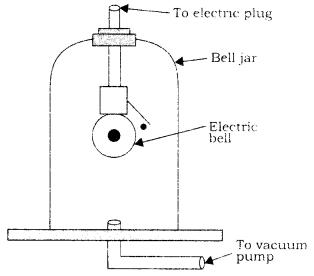
We consider an electric bell inside a closed glass, connected with a vacuum pump. When the glass jar is not vacuumised, the sound reaches to us on the ringing of a bell. But, as the air is taken out from the glass by using a vacuum pump, we will not hear any sound, when there is a perfect vacuum in the jar. This observation confirms the fact that sound requires a material medium to propagate.
Question 10.
By what name is the outer ear called? What is its function? Where are the vibrations in the eardrum amplified w the ear?
Answer
The outer ear is called pinna. It collects the sound from the surroundings and passes on to the eardrum through the auditory canal. The vibrations in the eardrum are amplified by Three bones, (the hammer, anvil and stirrup) in the middle ear.
Question 11.
Distinguish between musical sound and noise?
Answer
Musical sound:
- It is pleasant to hear.
- The pitch and loudness do not change suddenly.
- The sound is repeated periodically.
Noise:
- Jarring and unpleasant to hear.
- The pitch and loudness change very much.
- There is no periodic repetitions of frequency.
Question 12.
When a sound is reflected from a distant object, an echo is produced. Let the distance between the reflecting surface and the source of sound production remains the same. Do you hear echo sound on a hotter day?
Answer
On the hotter day, the speed of sound increases. Due to increased speed, the reflected sound come back of the source earlier than 0.1 second. Hence a distinct echo cannot be heard.
Question 13.
A person clapped his hands near a cliff and heard the echo after 5 seconds. What is the distance of the cliff from the person if the speed of sound V is taken as 346 m/sec.
Answer
Given V = 346 m/s, t = 5 second
Distance travelled = V x t
S = 346 x 5 = 1730 m i.e., in 5 seconds, the sound has to travel twice the distance between the cliff and the person. Thus, the distance between the cliff and the person
\( =\cfrac { 1730 }{ 2 } =865metres \)
Question 14.
A ship sends out ultrasound that returns from the seabed and is directed after 3.42 s. If the speed of ultrasound through seawater is 1531 m/sec. What is the distance of the seabed from the ship?
Answer
Given: Time between transmission and
detection t = 3.42 sec
Speed of ultrasound in seawater V = 1531 m/s.
Let the depth of sea is d then distance travelled by ultrasound wave
2 d = speed of sound x time
i.e. 2d = V x t
2d = 1531 x 3.42
\( d=\cfrac { 1531\times 3.42 }{ 2 } =\cfrac { 5236 }{ 2 } \)
d= 2618
Thus, the distance of the sea bed from the ship is 2618 m.
Question 15.
A sound wave travels at a speed of 339m/s. If its wavelength is 1.5 cm, what is the frequency of the wave? Will it be audible?
Answer
Speed of sound wave, V = 339 m/s;
Wavelength X = 1.5 cm = 0.015 m
\( Frequency\quad \upsilon =\cfrac { V }{ \lambda } \)
\( \upsilon =\cfrac { 339 }{ 0.015 } =22,600Hz \)
As thier requency is higher than the audible range of human ear (20 KHz), so it is not audible.
Question 16.
The frequency of a source of sound is 250 Hz. Calculate the number of times, the sound vibrates in one minute. Also, calculate the time period?
Answer
Given frequency v = 250 Hz
Thus, the number of vibrations of the source of sound in one second = 250
Therefore no. of vibrations in one minute = 250 x 60 = 15000
The time period, \( T=\cfrac { 1 }{ \upsilon } =\cfrac { 1 }{ 250 } \)
T = 0.004 second
Question 17.
If a man hears the thunder 5 seconds after lightning is seen, how far is the lightning from the man? Given, the speed of sound is 344 m/s.
Answer
Given V = 344 m/s; t = 5 second
The distance travelled by sound produced due to thunder before to reach the ears of man,
S = V x t; S = 344 x 5
S= 1720 metre = 1.72 km
The man is 1.72 km far from the source of lightning.
Question 18.
An echo returned in 3s. What is the distance of the reflecting surface from the source? Given that the speed of sound is 342 m/s?
Answer
Time (t) = 3 second;
velocity (v) = 342 m/sec.
The distance between the source and reflecting surface be s, then
\( S=\cfrac { vt }{ 2 } \Longrightarrow S=\cfrac { 342\times 3 }{ 2 } =513\quad metres\quad \)
Question 19.
A boy watches Dusshera celebration from a distance and sees the effigy of Ravana burn into flames and nears the explosion after 2 seconds. How far was he from the effigy if the speed of sound in air was 335 m/s.
Answer
The speed of sound in air = 335 m/s Distance
\( v=\cfrac { Distance }{ Time } \)
\( 335=\cfrac { Distance }{ 2 }=Distance=670m \)
Question 20.
A jerks is given to a toy slinky to produce a longitudinal wave. The wave travels at a speed of 30 cm/s and it has a frequency of 20 Hz. Find the minimum separation distance between consecutive rarefactions of the slinky.
Answer
We are given that
Frequency (ν) = 20 Hz
Speed (ν) = 30 cm/s = 0.30 m/s
Wave length (λ) =?
V = vλ
0.30 = 20 x λ
∴ \( \lambda =\cfrac { 0.30 }{ 20 } =0.015m \)
Sound Long Answer Type Questions
Question 1.
(a) What is reverberation? What will happen if the reverberation time in a big hall is too long? How can we reduce it?
(b) Which property of sound leads to the formation of echo? Briefly explain.
Answer
(a) Reverberation: The repeated reflection of sound waves that results in the persistence of sound for some time is called reverberation.
- In a big hall or an auditorium, along reverberation is highly undesirable. It makes the sound distorted, blur red and confusing.
Methods for reducing reverberation:
- To reduce the undesirable effects due to reverberation, roof and walls of the auditorium are generally covered with sound-absorbent materials like compressed fibreboard, rough plaster or draperies.
- The seat materials are also selected, having sound absorbing properties, Carpets are used to absorb the sound. Curtains are used on doors and windows to absorb the sound.
(b) Reflection of sound leads to the formation of echo. When a sound is repeatedly reflected from a number of obstacles, such as two parallel distant buildings or hills, more than one echo can be heard.
Question 2.
Explain how the ‘Echo’ is produced. What should be the minimum distance between the listener and the reflector to hear an echo of sound propagating with a speed v ms-1?
Answer
The sound that we hear leaves an impression on our mind for 1/10th of a second. We are, therefore able to distinguish between two sounds clearly, only if the time interval of sound waves reaching our ear is greater than 1/10th of a second. We also know that sound travels at a speed of 344 m/s at 20°C. Therefore, the distance travelled by the sound in 1/10th second is 34.4 m. If the observer is situated at a distance of 17.2 m from the reflecting surface, then the distance travelled by the sound from the observer to reflecting surface and then from reflecting surface to the observer is 34.4 m. This reflected sound can be distinctly heard by the observer because it takes the second to reach the observer. 10
Therefore, the minimum distance of the observer from the reflecting surface is 17.2 m.
Question 3.
A sonar echo takes 3 sec to return from a whale. How far away is the whale from the sonar? The speed of sound in seawater is 1440 m/s.
Answer
Let the distance from SONAR to whale be ‘d’.
Total distance travelled by echo = 2 d
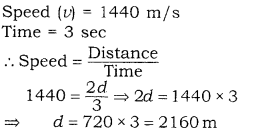
Question 4.
A stone is dropped from the top of a tower 500 m high into a pond of water, at the base of the tower. When is the splash beared at the top? Given g = 10 m/s2 and speed of sound = 340 m/s.
Answer
Given: h = 500 m, g = 10 m/s2,
v = 340 m/s
Initial velocity (u) = 0
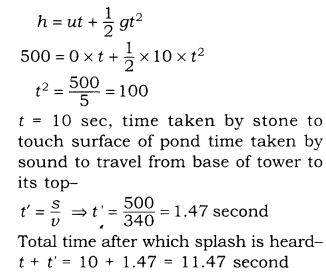
Question 5.
With a diagram explaining the use of curved soundboard behind the speaker in conference halls?
Answer
The arched ceiling and walls of large halls often reflect the sound waves. These reflected sound waves interfere with the words of the speaker. This problem is solved by hanging curtains, putting up screens or by using soundboards. A soundboard is often a concave rigid surface.
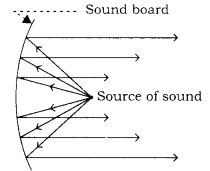
The speaker is located at the focus of the sound board, placed behind the speaker. The soundboard renders the reflected sound waves parallel. This enables the sound to reach large distance. The sound board prevents the spreading out of the sound waves in a different direction.
Question 6.
Is there any technique to detect cracks and flaws in a block of metal? If yes, the explain it with labelled diagram.
Or
Explain, how defects in a metal block can be detected using ultrasound.
Answer
The flaws like internal cracks, etc. in the metal blocks are detected by using ultrasound, it is based on the fact that internal crack or hole in the block does not allow ultrasonic waves to pass through it. To detect a flaw in the metallic block, a source of ultrasonic sound is placed in front of one face of the block and a detector on the opposite face. The ultrasonic waves are produced and made to pass through one face of the block and detected on the opposite face.
(a) If the ultrasonic waves pass uninterrupted through all parts of the block, then there is no defect in the block.
(b) If the ultrasonic waves do not reach the opposite face, then the block has a defect.
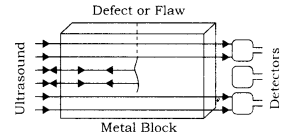
We hope the given RBSE Solutions for Class 9 Science Chapter 11 Sound will help you. If you have any query regarding Rajasthan Board RBSE Class 9 Science Chapter 11 Sound, drop a comment below and we will get back to you at the earliest.